Logistic and Supply Chain Management in Men's Shirt Manufacturing
VerifiedAdded on 2023/04/23
|15
|3090
|385
AI Summary
This assignment elaborates on the importance of supply chain management in men's shirt manufacturing. The process is emphasized from raw material to finished goods. Effective knowledge regarding logistic and supply chain management is provided.
Contribute Materials
Your contribution can guide someone’s learning journey. Share your
documents today.

Logistic and Supply Chain 1
Logistic and Supply Chain
Logistic and Supply Chain
Secure Best Marks with AI Grader
Need help grading? Try our AI Grader for instant feedback on your assignments.
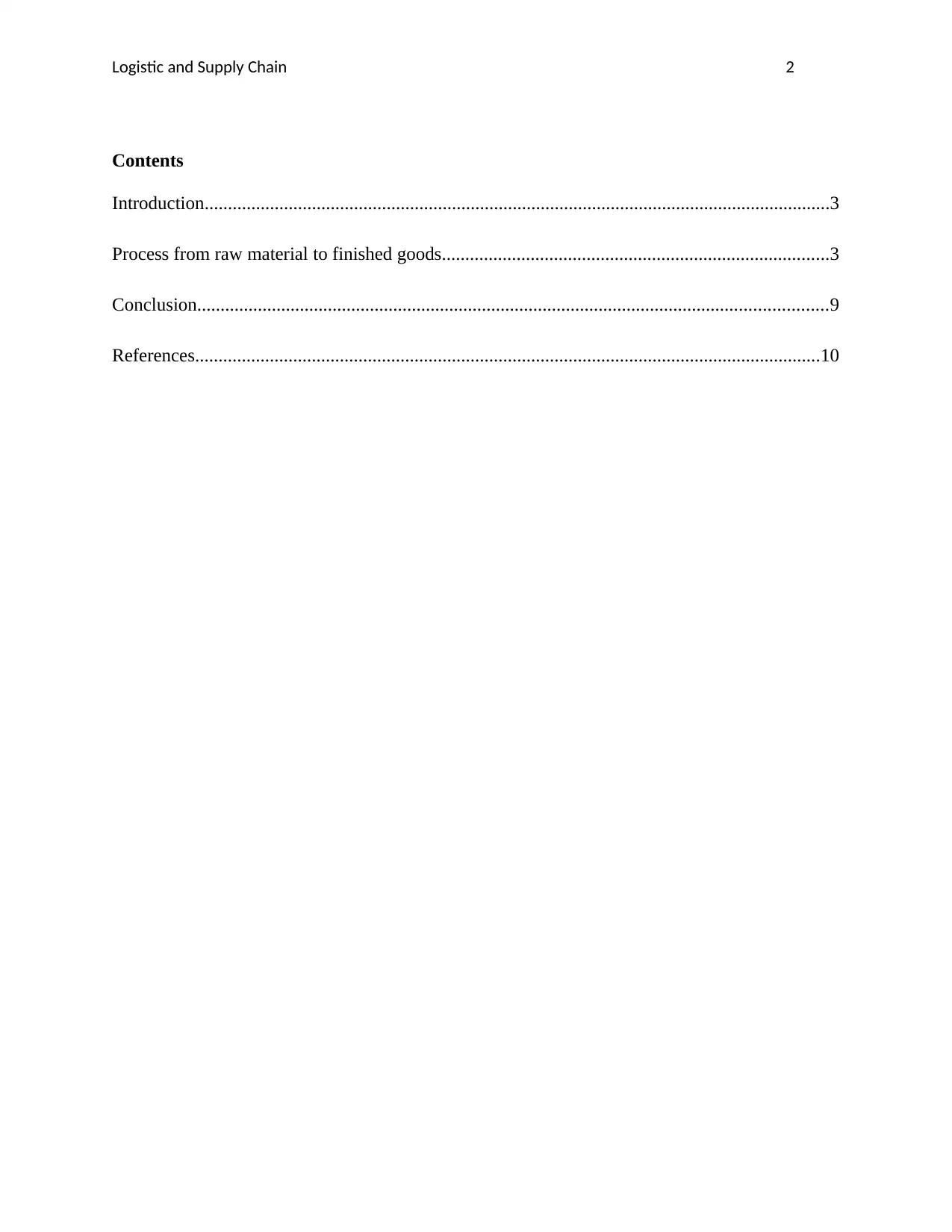
Logistic and Supply Chain 2
Contents
Introduction......................................................................................................................................3
Process from raw material to finished goods...................................................................................3
Conclusion.......................................................................................................................................9
References......................................................................................................................................10
Contents
Introduction......................................................................................................................................3
Process from raw material to finished goods...................................................................................3
Conclusion.......................................................................................................................................9
References......................................................................................................................................10
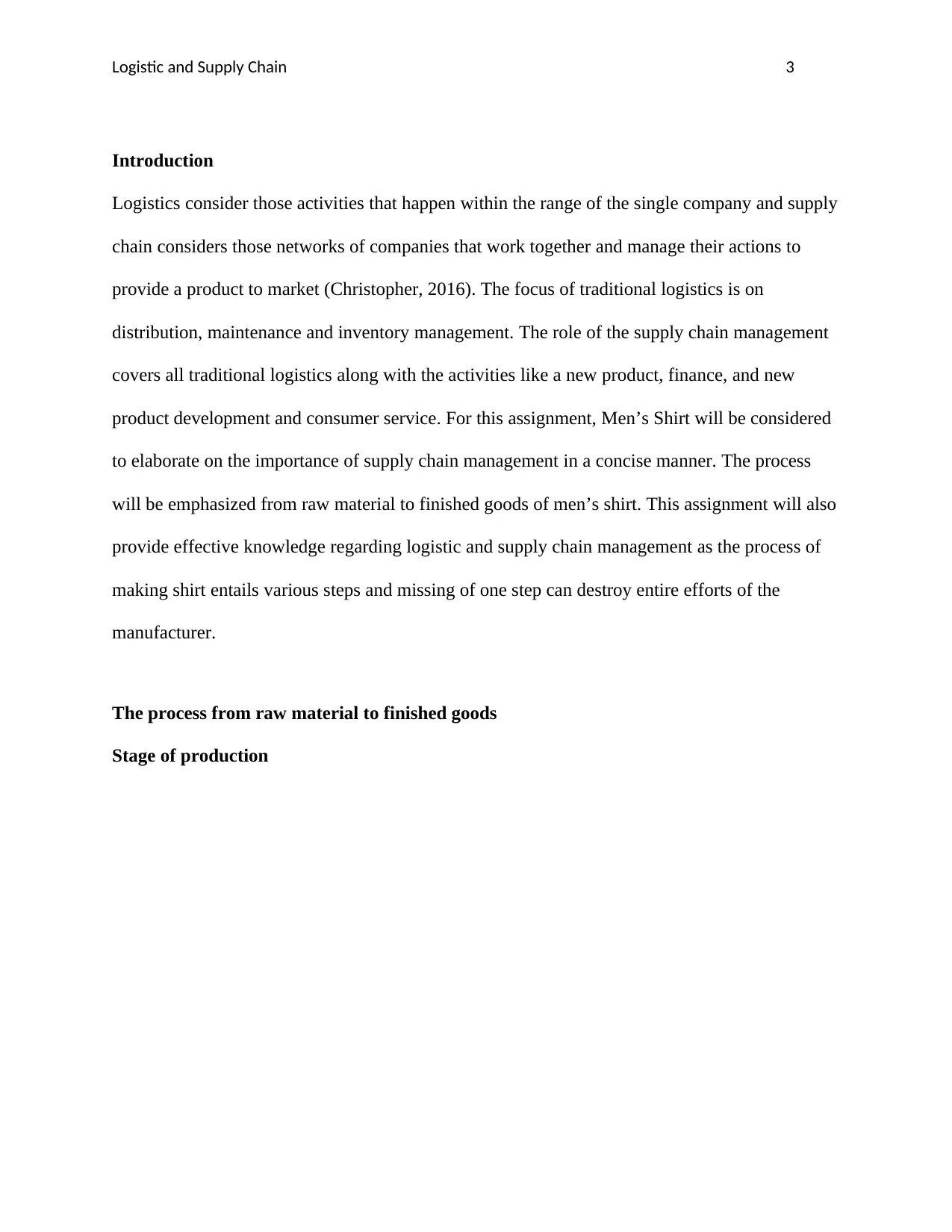
Logistic and Supply Chain 3
Introduction
Logistics consider those activities that happen within the range of the single company and supply
chain considers those networks of companies that work together and manage their actions to
provide a product to market (Christopher, 2016). The focus of traditional logistics is on
distribution, maintenance and inventory management. The role of the supply chain management
covers all traditional logistics along with the activities like a new product, finance, and new
product development and consumer service. For this assignment, Men’s Shirt will be considered
to elaborate on the importance of supply chain management in a concise manner. The process
will be emphasized from raw material to finished goods of men’s shirt. This assignment will also
provide effective knowledge regarding logistic and supply chain management as the process of
making shirt entails various steps and missing of one step can destroy entire efforts of the
manufacturer.
The process from raw material to finished goods
Stage of production
Introduction
Logistics consider those activities that happen within the range of the single company and supply
chain considers those networks of companies that work together and manage their actions to
provide a product to market (Christopher, 2016). The focus of traditional logistics is on
distribution, maintenance and inventory management. The role of the supply chain management
covers all traditional logistics along with the activities like a new product, finance, and new
product development and consumer service. For this assignment, Men’s Shirt will be considered
to elaborate on the importance of supply chain management in a concise manner. The process
will be emphasized from raw material to finished goods of men’s shirt. This assignment will also
provide effective knowledge regarding logistic and supply chain management as the process of
making shirt entails various steps and missing of one step can destroy entire efforts of the
manufacturer.
The process from raw material to finished goods
Stage of production
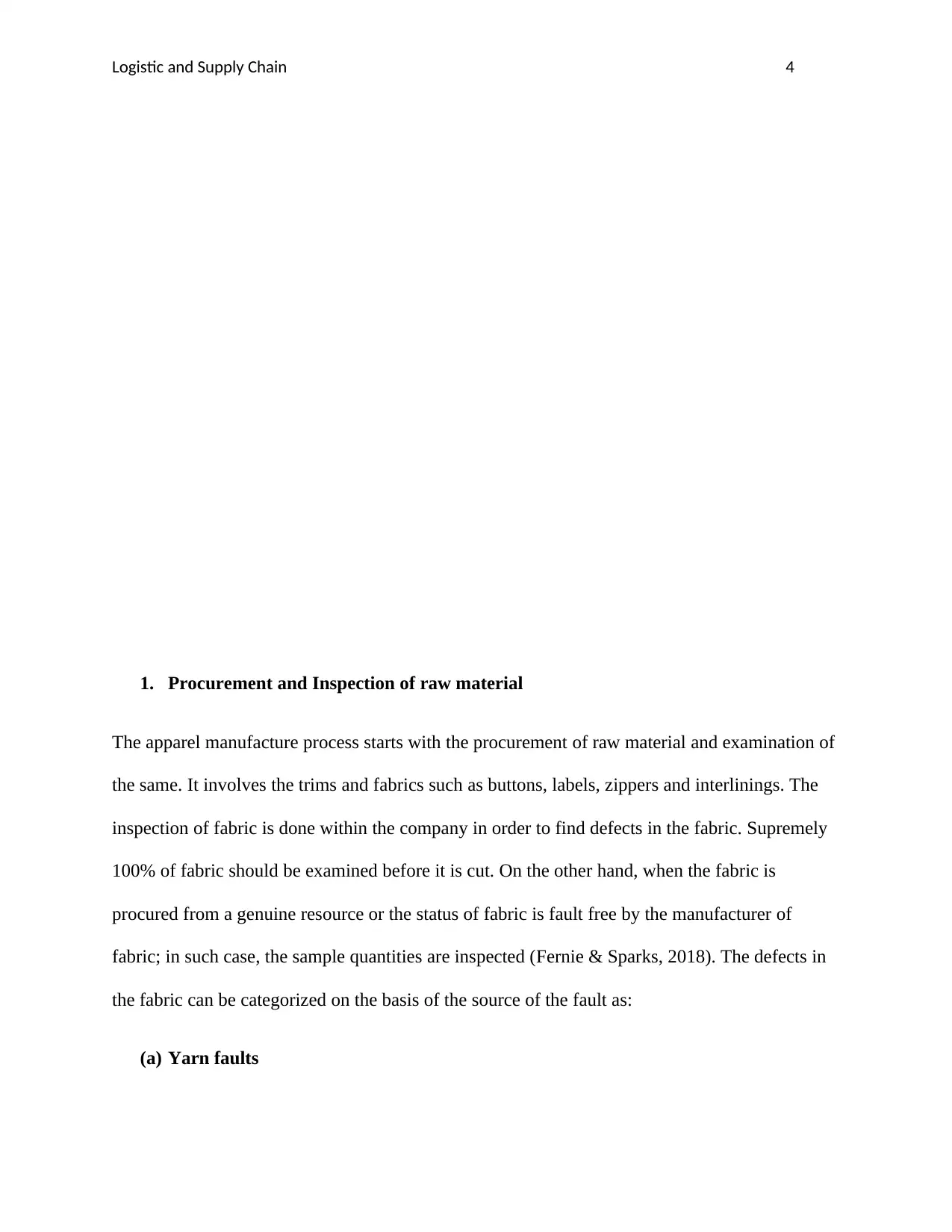
Logistic and Supply Chain 4
1. Procurement and Inspection of raw material
The apparel manufacture process starts with the procurement of raw material and examination of
the same. It involves the trims and fabrics such as buttons, labels, zippers and interlinings. The
inspection of fabric is done within the company in order to find defects in the fabric. Supremely
100% of fabric should be examined before it is cut. On the other hand, when the fabric is
procured from a genuine resource or the status of fabric is fault free by the manufacturer of
fabric; in such case, the sample quantities are inspected (Fernie & Sparks, 2018). The defects in
the fabric can be categorized on the basis of the source of the fault as:
(a) Yarn faults
1. Procurement and Inspection of raw material
The apparel manufacture process starts with the procurement of raw material and examination of
the same. It involves the trims and fabrics such as buttons, labels, zippers and interlinings. The
inspection of fabric is done within the company in order to find defects in the fabric. Supremely
100% of fabric should be examined before it is cut. On the other hand, when the fabric is
procured from a genuine resource or the status of fabric is fault free by the manufacturer of
fabric; in such case, the sample quantities are inspected (Fernie & Sparks, 2018). The defects in
the fabric can be categorized on the basis of the source of the fault as:
(a) Yarn faults
Secure Best Marks with AI Grader
Need help grading? Try our AI Grader for instant feedback on your assignments.
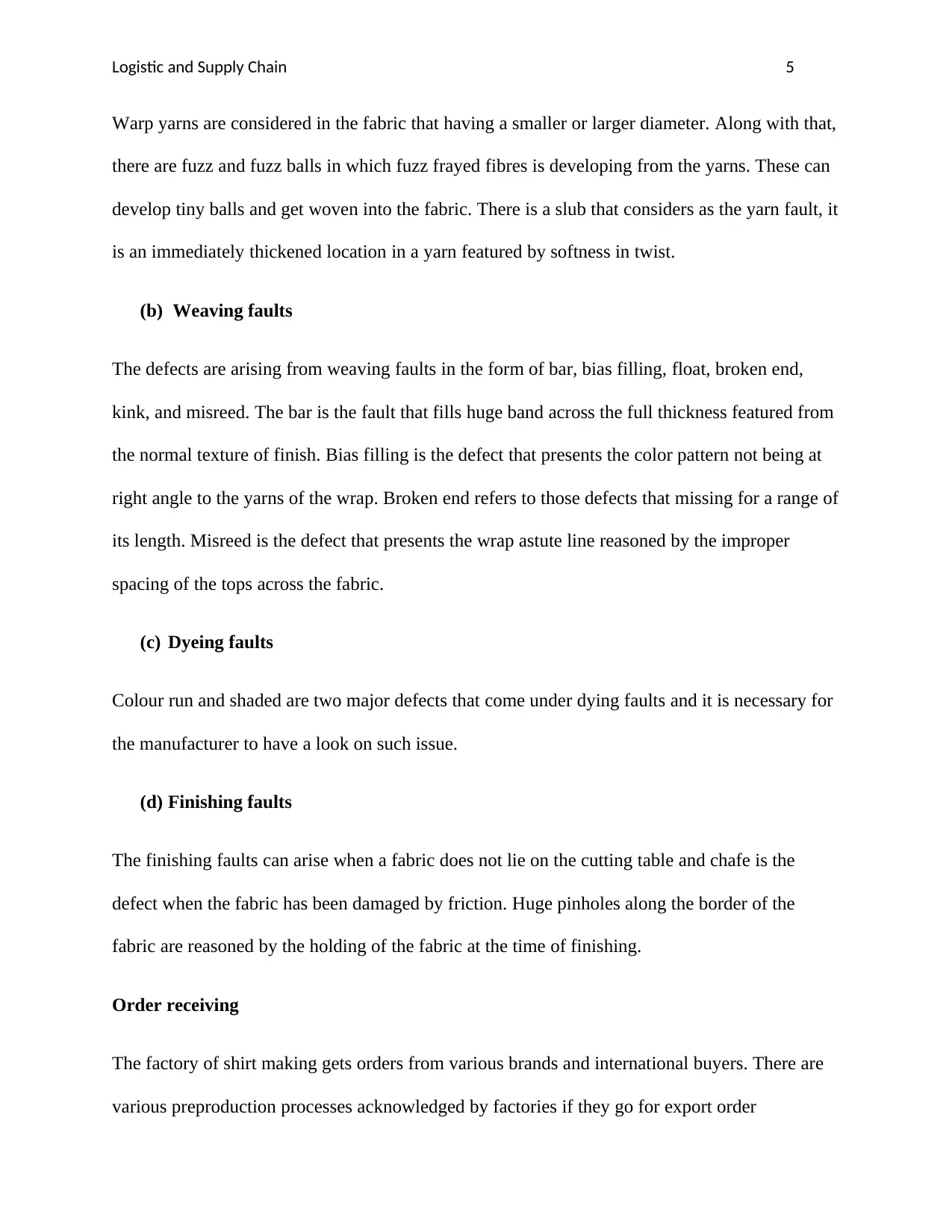
Logistic and Supply Chain 5
Warp yarns are considered in the fabric that having a smaller or larger diameter. Along with that,
there are fuzz and fuzz balls in which fuzz frayed fibres is developing from the yarns. These can
develop tiny balls and get woven into the fabric. There is a slub that considers as the yarn fault, it
is an immediately thickened location in a yarn featured by softness in twist.
(b) Weaving faults
The defects are arising from weaving faults in the form of bar, bias filling, float, broken end,
kink, and misreed. The bar is the fault that fills huge band across the full thickness featured from
the normal texture of finish. Bias filling is the defect that presents the color pattern not being at
right angle to the yarns of the wrap. Broken end refers to those defects that missing for a range of
its length. Misreed is the defect that presents the wrap astute line reasoned by the improper
spacing of the tops across the fabric.
(c) Dyeing faults
Colour run and shaded are two major defects that come under dying faults and it is necessary for
the manufacturer to have a look on such issue.
(d) Finishing faults
The finishing faults can arise when a fabric does not lie on the cutting table and chafe is the
defect when the fabric has been damaged by friction. Huge pinholes along the border of the
fabric are reasoned by the holding of the fabric at the time of finishing.
Order receiving
The factory of shirt making gets orders from various brands and international buyers. There are
various preproduction processes acknowledged by factories if they go for export order
Warp yarns are considered in the fabric that having a smaller or larger diameter. Along with that,
there are fuzz and fuzz balls in which fuzz frayed fibres is developing from the yarns. These can
develop tiny balls and get woven into the fabric. There is a slub that considers as the yarn fault, it
is an immediately thickened location in a yarn featured by softness in twist.
(b) Weaving faults
The defects are arising from weaving faults in the form of bar, bias filling, float, broken end,
kink, and misreed. The bar is the fault that fills huge band across the full thickness featured from
the normal texture of finish. Bias filling is the defect that presents the color pattern not being at
right angle to the yarns of the wrap. Broken end refers to those defects that missing for a range of
its length. Misreed is the defect that presents the wrap astute line reasoned by the improper
spacing of the tops across the fabric.
(c) Dyeing faults
Colour run and shaded are two major defects that come under dying faults and it is necessary for
the manufacturer to have a look on such issue.
(d) Finishing faults
The finishing faults can arise when a fabric does not lie on the cutting table and chafe is the
defect when the fabric has been damaged by friction. Huge pinholes along the border of the
fabric are reasoned by the holding of the fabric at the time of finishing.
Order receiving
The factory of shirt making gets orders from various brands and international buyers. There are
various preproduction processes acknowledged by factories if they go for export order
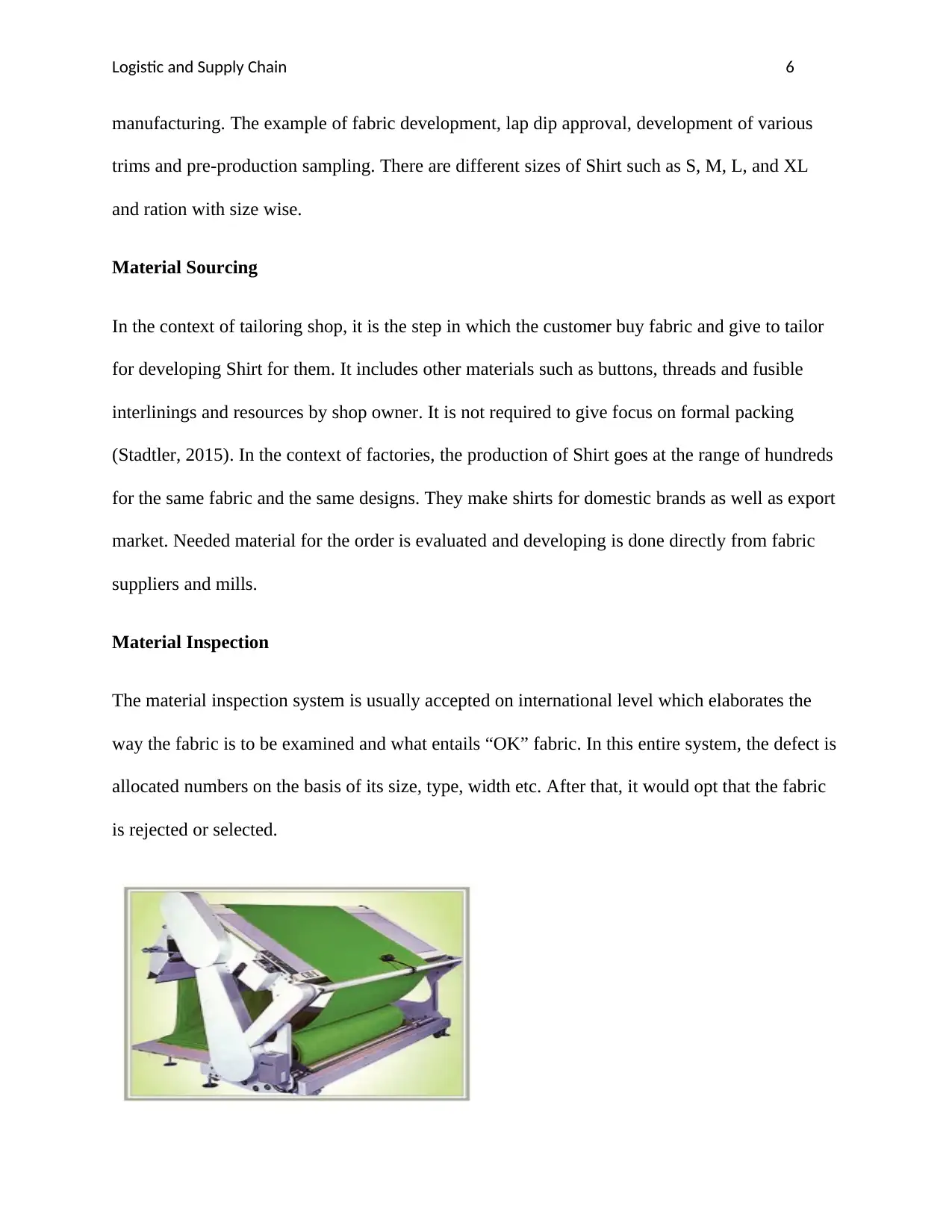
Logistic and Supply Chain 6
manufacturing. The example of fabric development, lap dip approval, development of various
trims and pre-production sampling. There are different sizes of Shirt such as S, M, L, and XL
and ration with size wise.
Material Sourcing
In the context of tailoring shop, it is the step in which the customer buy fabric and give to tailor
for developing Shirt for them. It includes other materials such as buttons, threads and fusible
interlinings and resources by shop owner. It is not required to give focus on formal packing
(Stadtler, 2015). In the context of factories, the production of Shirt goes at the range of hundreds
for the same fabric and the same designs. They make shirts for domestic brands as well as export
market. Needed material for the order is evaluated and developing is done directly from fabric
suppliers and mills.
Material Inspection
The material inspection system is usually accepted on international level which elaborates the
way the fabric is to be examined and what entails “OK” fabric. In this entire system, the defect is
allocated numbers on the basis of its size, type, width etc. After that, it would opt that the fabric
is rejected or selected.
manufacturing. The example of fabric development, lap dip approval, development of various
trims and pre-production sampling. There are different sizes of Shirt such as S, M, L, and XL
and ration with size wise.
Material Sourcing
In the context of tailoring shop, it is the step in which the customer buy fabric and give to tailor
for developing Shirt for them. It includes other materials such as buttons, threads and fusible
interlinings and resources by shop owner. It is not required to give focus on formal packing
(Stadtler, 2015). In the context of factories, the production of Shirt goes at the range of hundreds
for the same fabric and the same designs. They make shirts for domestic brands as well as export
market. Needed material for the order is evaluated and developing is done directly from fabric
suppliers and mills.
Material Inspection
The material inspection system is usually accepted on international level which elaborates the
way the fabric is to be examined and what entails “OK” fabric. In this entire system, the defect is
allocated numbers on the basis of its size, type, width etc. After that, it would opt that the fabric
is rejected or selected.
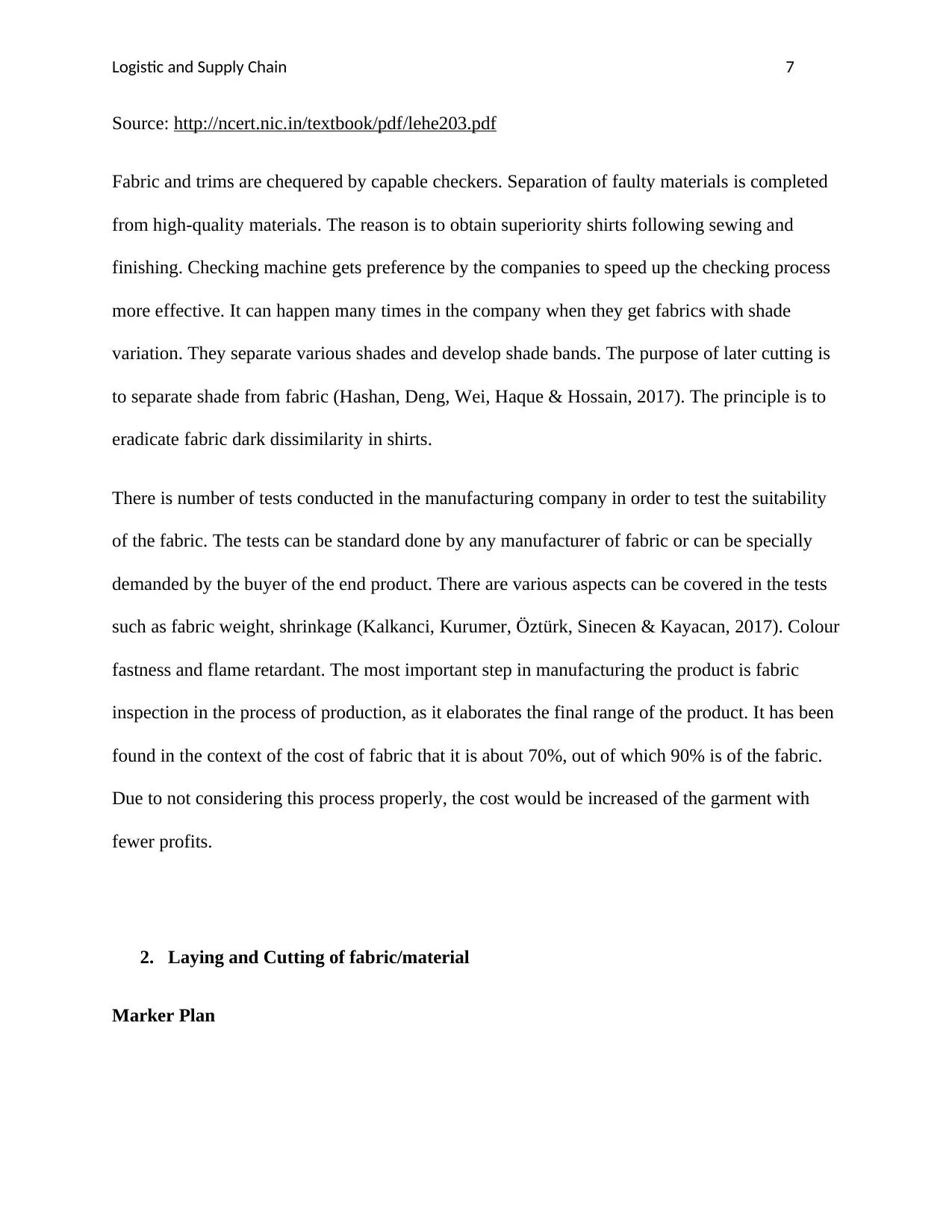
Logistic and Supply Chain 7
Source: http://ncert.nic.in/textbook/pdf/lehe203.pdf
Fabric and trims are chequered by capable checkers. Separation of faulty materials is completed
from high-quality materials. The reason is to obtain superiority shirts following sewing and
finishing. Checking machine gets preference by the companies to speed up the checking process
more effective. It can happen many times in the company when they get fabrics with shade
variation. They separate various shades and develop shade bands. The purpose of later cutting is
to separate shade from fabric (Hashan, Deng, Wei, Haque & Hossain, 2017). The principle is to
eradicate fabric dark dissimilarity in shirts.
There is number of tests conducted in the manufacturing company in order to test the suitability
of the fabric. The tests can be standard done by any manufacturer of fabric or can be specially
demanded by the buyer of the end product. There are various aspects can be covered in the tests
such as fabric weight, shrinkage (Kalkanci, Kurumer, Öztürk, Sinecen & Kayacan, 2017). Colour
fastness and flame retardant. The most important step in manufacturing the product is fabric
inspection in the process of production, as it elaborates the final range of the product. It has been
found in the context of the cost of fabric that it is about 70%, out of which 90% is of the fabric.
Due to not considering this process properly, the cost would be increased of the garment with
fewer profits.
2. Laying and Cutting of fabric/material
Marker Plan
Source: http://ncert.nic.in/textbook/pdf/lehe203.pdf
Fabric and trims are chequered by capable checkers. Separation of faulty materials is completed
from high-quality materials. The reason is to obtain superiority shirts following sewing and
finishing. Checking machine gets preference by the companies to speed up the checking process
more effective. It can happen many times in the company when they get fabrics with shade
variation. They separate various shades and develop shade bands. The purpose of later cutting is
to separate shade from fabric (Hashan, Deng, Wei, Haque & Hossain, 2017). The principle is to
eradicate fabric dark dissimilarity in shirts.
There is number of tests conducted in the manufacturing company in order to test the suitability
of the fabric. The tests can be standard done by any manufacturer of fabric or can be specially
demanded by the buyer of the end product. There are various aspects can be covered in the tests
such as fabric weight, shrinkage (Kalkanci, Kurumer, Öztürk, Sinecen & Kayacan, 2017). Colour
fastness and flame retardant. The most important step in manufacturing the product is fabric
inspection in the process of production, as it elaborates the final range of the product. It has been
found in the context of the cost of fabric that it is about 70%, out of which 90% is of the fabric.
Due to not considering this process properly, the cost would be increased of the garment with
fewer profits.
2. Laying and Cutting of fabric/material
Marker Plan
Paraphrase This Document
Need a fresh take? Get an instant paraphrase of this document with our AI Paraphraser
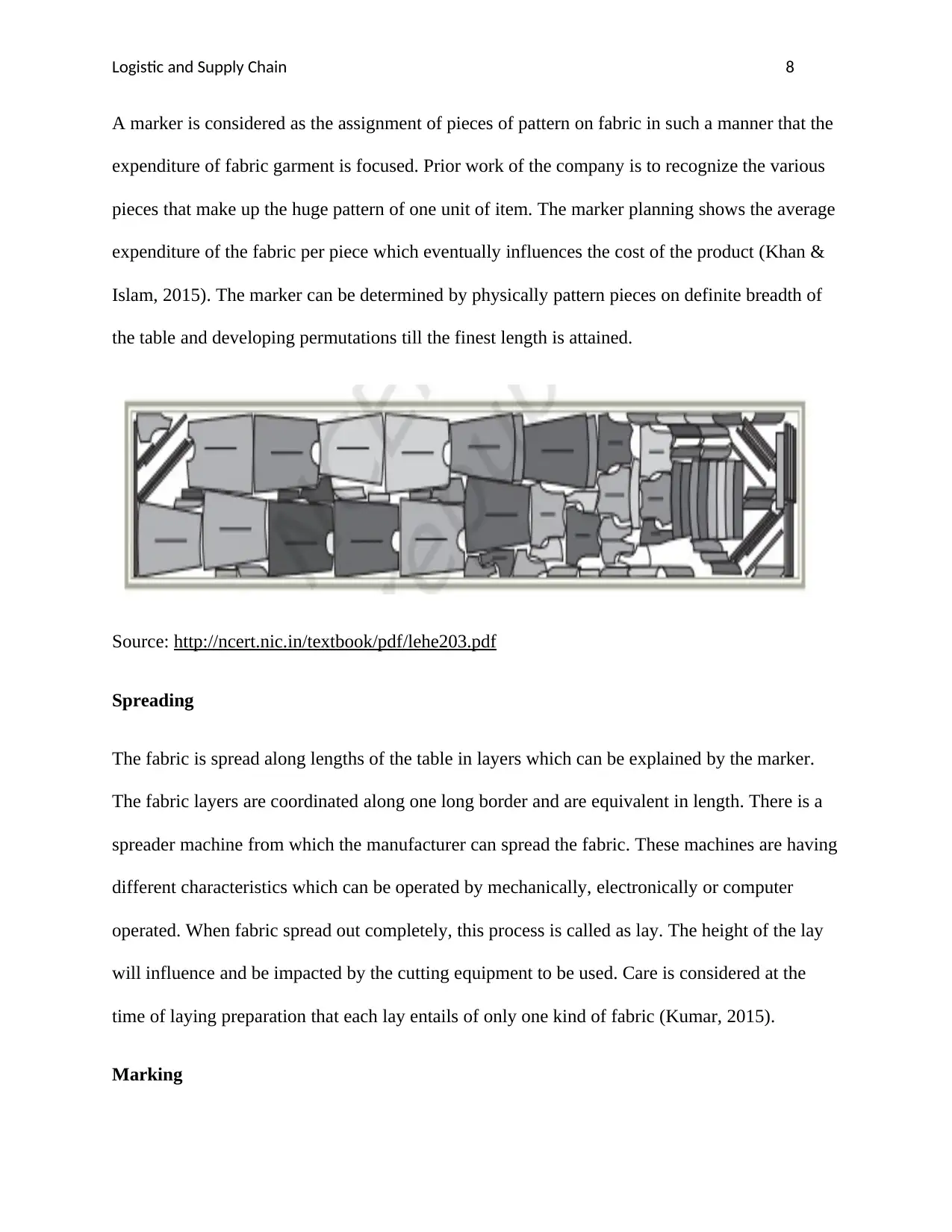
Logistic and Supply Chain 8
A marker is considered as the assignment of pieces of pattern on fabric in such a manner that the
expenditure of fabric garment is focused. Prior work of the company is to recognize the various
pieces that make up the huge pattern of one unit of item. The marker planning shows the average
expenditure of the fabric per piece which eventually influences the cost of the product (Khan &
Islam, 2015). The marker can be determined by physically pattern pieces on definite breadth of
the table and developing permutations till the finest length is attained.
Source: http://ncert.nic.in/textbook/pdf/lehe203.pdf
Spreading
The fabric is spread along lengths of the table in layers which can be explained by the marker.
The fabric layers are coordinated along one long border and are equivalent in length. There is a
spreader machine from which the manufacturer can spread the fabric. These machines are having
different characteristics which can be operated by mechanically, electronically or computer
operated. When fabric spread out completely, this process is called as lay. The height of the lay
will influence and be impacted by the cutting equipment to be used. Care is considered at the
time of laying preparation that each lay entails of only one kind of fabric (Kumar, 2015).
Marking
A marker is considered as the assignment of pieces of pattern on fabric in such a manner that the
expenditure of fabric garment is focused. Prior work of the company is to recognize the various
pieces that make up the huge pattern of one unit of item. The marker planning shows the average
expenditure of the fabric per piece which eventually influences the cost of the product (Khan &
Islam, 2015). The marker can be determined by physically pattern pieces on definite breadth of
the table and developing permutations till the finest length is attained.
Source: http://ncert.nic.in/textbook/pdf/lehe203.pdf
Spreading
The fabric is spread along lengths of the table in layers which can be explained by the marker.
The fabric layers are coordinated along one long border and are equivalent in length. There is a
spreader machine from which the manufacturer can spread the fabric. These machines are having
different characteristics which can be operated by mechanically, electronically or computer
operated. When fabric spread out completely, this process is called as lay. The height of the lay
will influence and be impacted by the cutting equipment to be used. Care is considered at the
time of laying preparation that each lay entails of only one kind of fabric (Kumar, 2015).
Marking
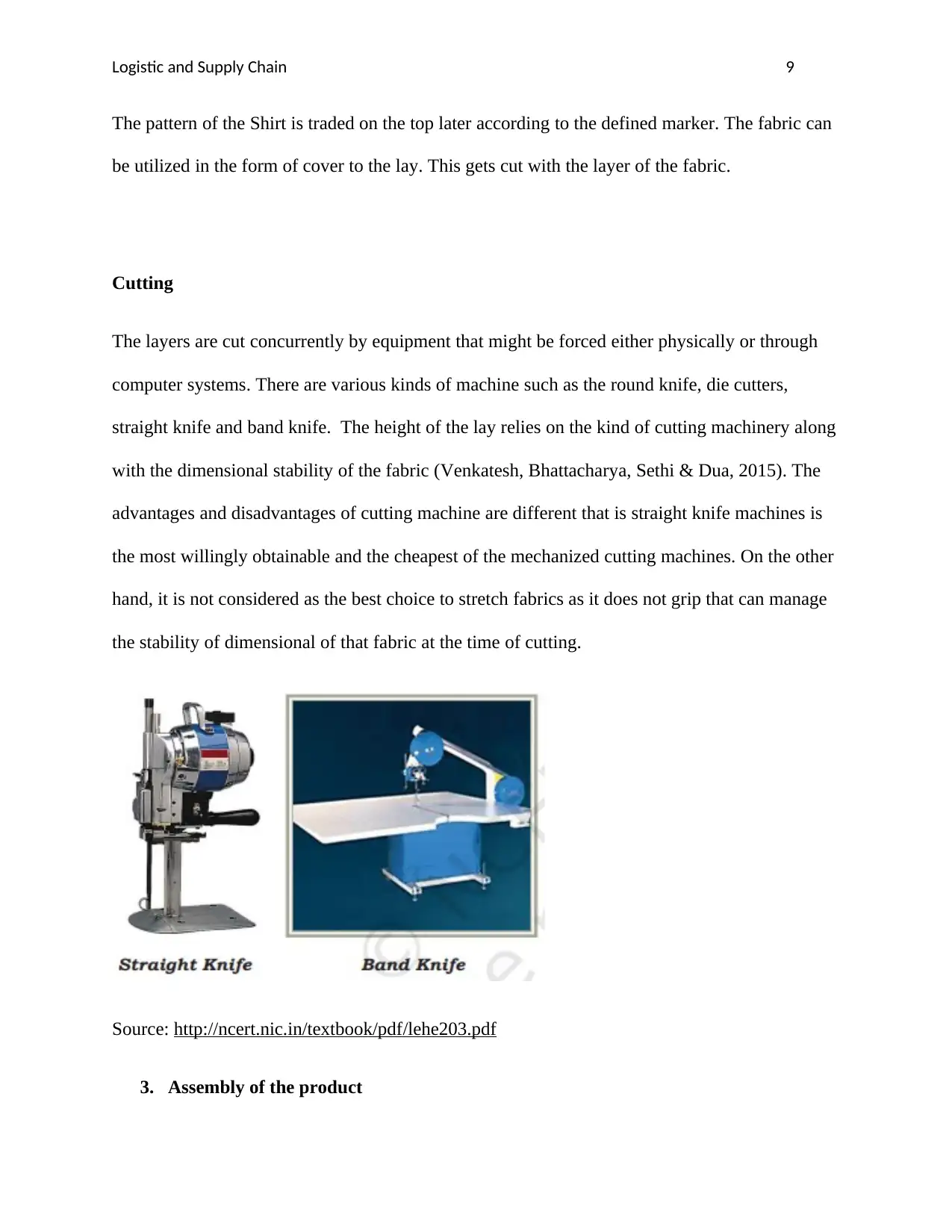
Logistic and Supply Chain 9
The pattern of the Shirt is traded on the top later according to the defined marker. The fabric can
be utilized in the form of cover to the lay. This gets cut with the layer of the fabric.
Cutting
The layers are cut concurrently by equipment that might be forced either physically or through
computer systems. There are various kinds of machine such as the round knife, die cutters,
straight knife and band knife. The height of the lay relies on the kind of cutting machinery along
with the dimensional stability of the fabric (Venkatesh, Bhattacharya, Sethi & Dua, 2015). The
advantages and disadvantages of cutting machine are different that is straight knife machines is
the most willingly obtainable and the cheapest of the mechanized cutting machines. On the other
hand, it is not considered as the best choice to stretch fabrics as it does not grip that can manage
the stability of dimensional of that fabric at the time of cutting.
Source: http://ncert.nic.in/textbook/pdf/lehe203.pdf
3. Assembly of the product
The pattern of the Shirt is traded on the top later according to the defined marker. The fabric can
be utilized in the form of cover to the lay. This gets cut with the layer of the fabric.
Cutting
The layers are cut concurrently by equipment that might be forced either physically or through
computer systems. There are various kinds of machine such as the round knife, die cutters,
straight knife and band knife. The height of the lay relies on the kind of cutting machinery along
with the dimensional stability of the fabric (Venkatesh, Bhattacharya, Sethi & Dua, 2015). The
advantages and disadvantages of cutting machine are different that is straight knife machines is
the most willingly obtainable and the cheapest of the mechanized cutting machines. On the other
hand, it is not considered as the best choice to stretch fabrics as it does not grip that can manage
the stability of dimensional of that fabric at the time of cutting.
Source: http://ncert.nic.in/textbook/pdf/lehe203.pdf
3. Assembly of the product
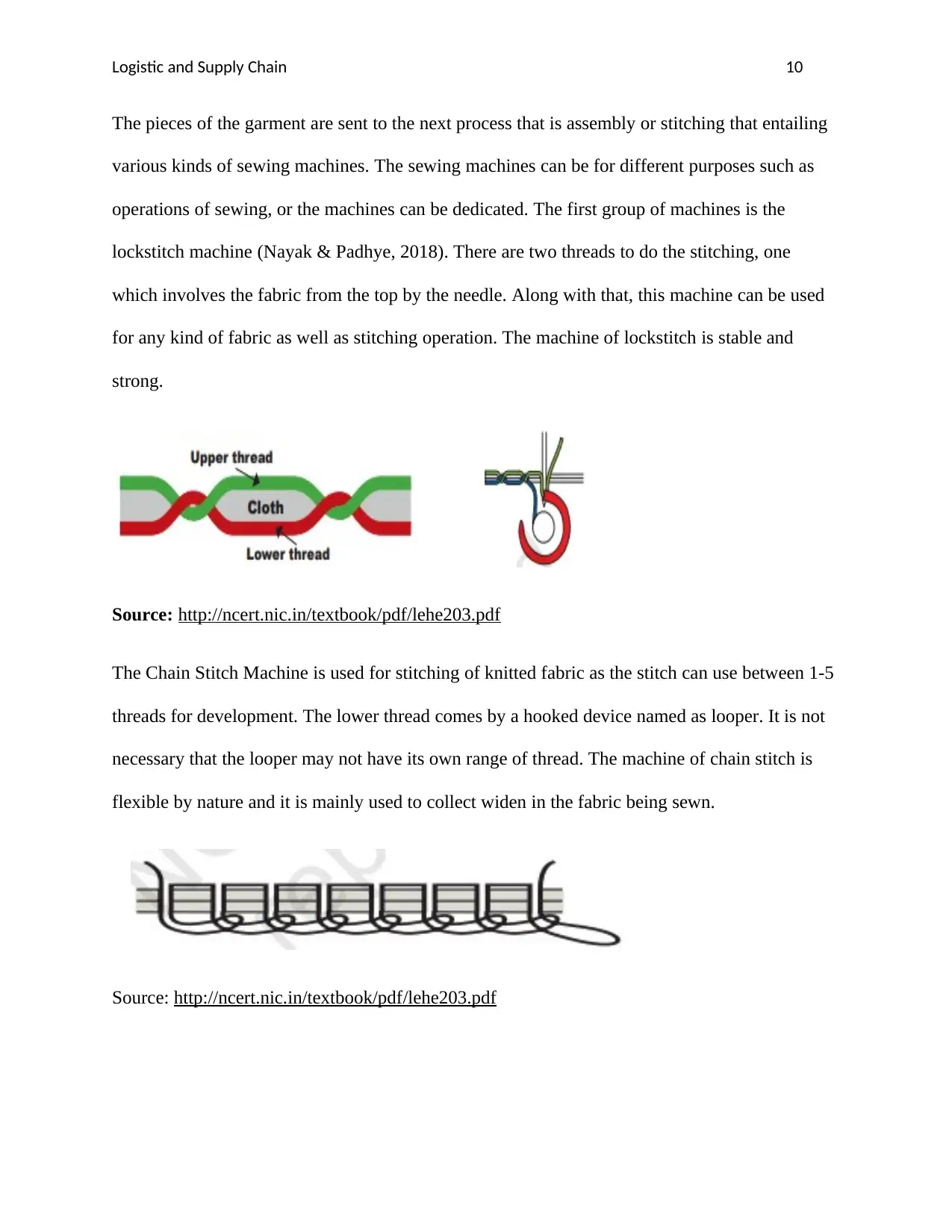
Logistic and Supply Chain 10
The pieces of the garment are sent to the next process that is assembly or stitching that entailing
various kinds of sewing machines. The sewing machines can be for different purposes such as
operations of sewing, or the machines can be dedicated. The first group of machines is the
lockstitch machine (Nayak & Padhye, 2018). There are two threads to do the stitching, one
which involves the fabric from the top by the needle. Along with that, this machine can be used
for any kind of fabric as well as stitching operation. The machine of lockstitch is stable and
strong.
Source: http://ncert.nic.in/textbook/pdf/lehe203.pdf
The Chain Stitch Machine is used for stitching of knitted fabric as the stitch can use between 1-5
threads for development. The lower thread comes by a hooked device named as looper. It is not
necessary that the looper may not have its own range of thread. The machine of chain stitch is
flexible by nature and it is mainly used to collect widen in the fabric being sewn.
Source: http://ncert.nic.in/textbook/pdf/lehe203.pdf
The pieces of the garment are sent to the next process that is assembly or stitching that entailing
various kinds of sewing machines. The sewing machines can be for different purposes such as
operations of sewing, or the machines can be dedicated. The first group of machines is the
lockstitch machine (Nayak & Padhye, 2018). There are two threads to do the stitching, one
which involves the fabric from the top by the needle. Along with that, this machine can be used
for any kind of fabric as well as stitching operation. The machine of lockstitch is stable and
strong.
Source: http://ncert.nic.in/textbook/pdf/lehe203.pdf
The Chain Stitch Machine is used for stitching of knitted fabric as the stitch can use between 1-5
threads for development. The lower thread comes by a hooked device named as looper. It is not
necessary that the looper may not have its own range of thread. The machine of chain stitch is
flexible by nature and it is mainly used to collect widen in the fabric being sewn.
Source: http://ncert.nic.in/textbook/pdf/lehe203.pdf
Secure Best Marks with AI Grader
Need help grading? Try our AI Grader for instant feedback on your assignments.
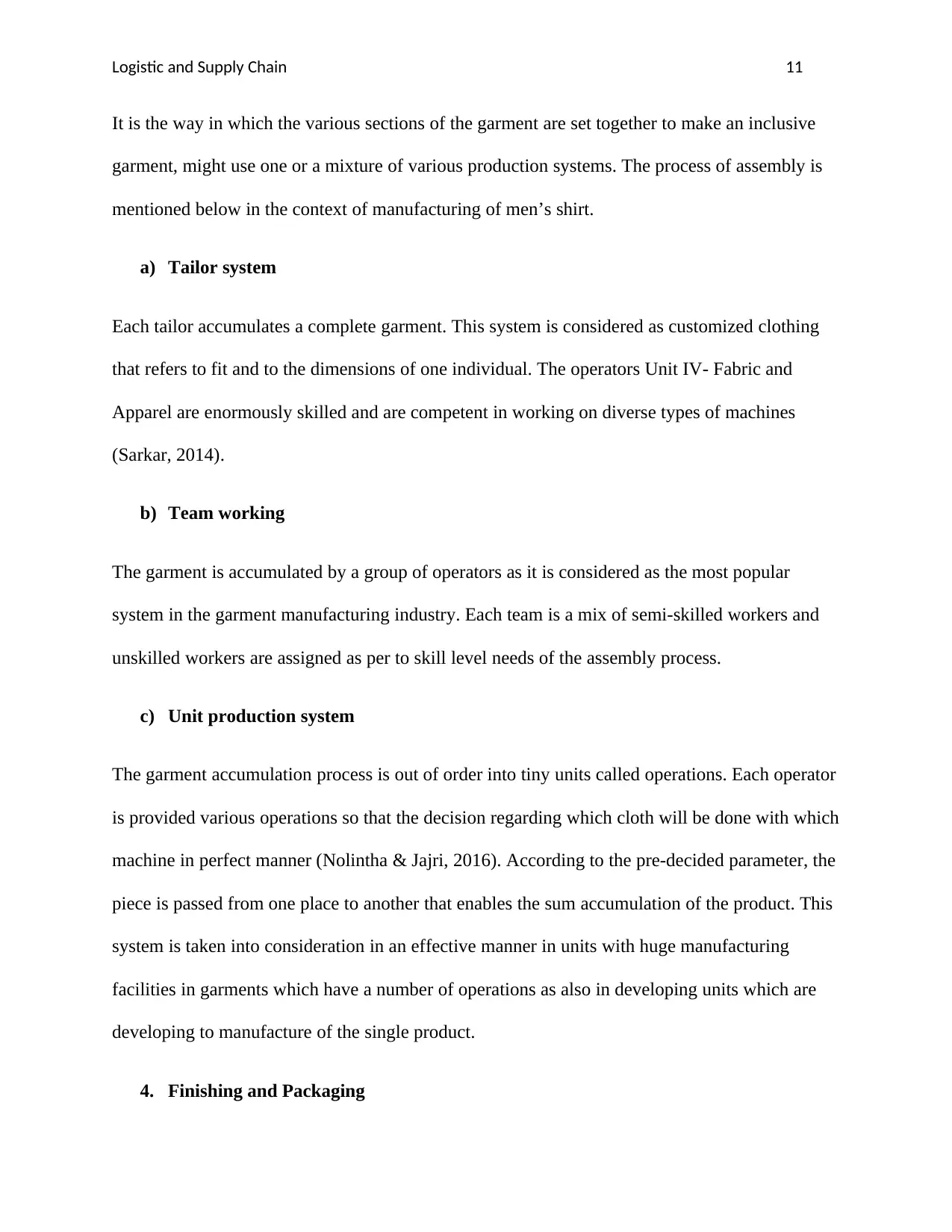
Logistic and Supply Chain 11
It is the way in which the various sections of the garment are set together to make an inclusive
garment, might use one or a mixture of various production systems. The process of assembly is
mentioned below in the context of manufacturing of men’s shirt.
a) Tailor system
Each tailor accumulates a complete garment. This system is considered as customized clothing
that refers to fit and to the dimensions of one individual. The operators Unit IV- Fabric and
Apparel are enormously skilled and are competent in working on diverse types of machines
(Sarkar, 2014).
b) Team working
The garment is accumulated by a group of operators as it is considered as the most popular
system in the garment manufacturing industry. Each team is a mix of semi-skilled workers and
unskilled workers are assigned as per to skill level needs of the assembly process.
c) Unit production system
The garment accumulation process is out of order into tiny units called operations. Each operator
is provided various operations so that the decision regarding which cloth will be done with which
machine in perfect manner (Nolintha & Jajri, 2016). According to the pre-decided parameter, the
piece is passed from one place to another that enables the sum accumulation of the product. This
system is taken into consideration in an effective manner in units with huge manufacturing
facilities in garments which have a number of operations as also in developing units which are
developing to manufacture of the single product.
4. Finishing and Packaging
It is the way in which the various sections of the garment are set together to make an inclusive
garment, might use one or a mixture of various production systems. The process of assembly is
mentioned below in the context of manufacturing of men’s shirt.
a) Tailor system
Each tailor accumulates a complete garment. This system is considered as customized clothing
that refers to fit and to the dimensions of one individual. The operators Unit IV- Fabric and
Apparel are enormously skilled and are competent in working on diverse types of machines
(Sarkar, 2014).
b) Team working
The garment is accumulated by a group of operators as it is considered as the most popular
system in the garment manufacturing industry. Each team is a mix of semi-skilled workers and
unskilled workers are assigned as per to skill level needs of the assembly process.
c) Unit production system
The garment accumulation process is out of order into tiny units called operations. Each operator
is provided various operations so that the decision regarding which cloth will be done with which
machine in perfect manner (Nolintha & Jajri, 2016). According to the pre-decided parameter, the
piece is passed from one place to another that enables the sum accumulation of the product. This
system is taken into consideration in an effective manner in units with huge manufacturing
facilities in garments which have a number of operations as also in developing units which are
developing to manufacture of the single product.
4. Finishing and Packaging
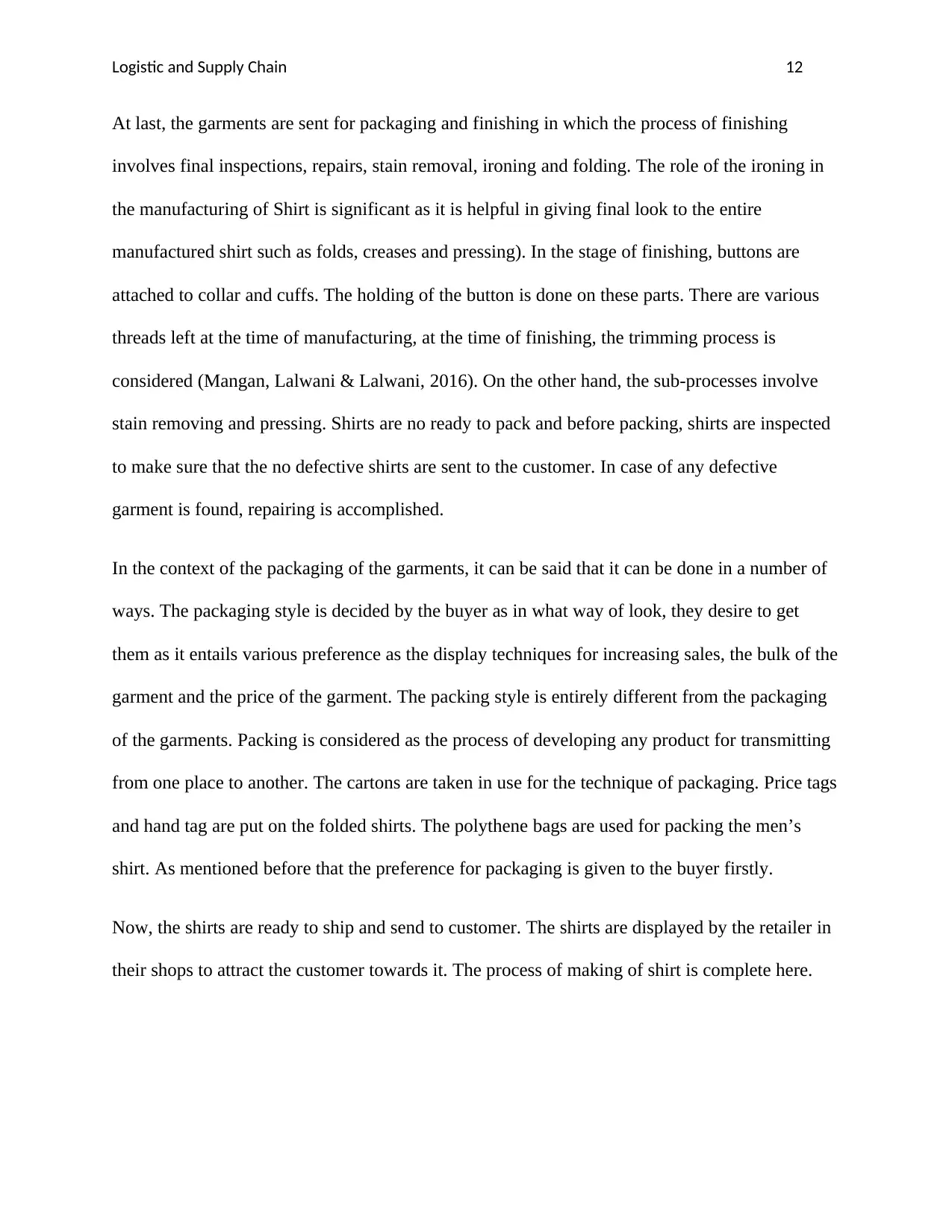
Logistic and Supply Chain 12
At last, the garments are sent for packaging and finishing in which the process of finishing
involves final inspections, repairs, stain removal, ironing and folding. The role of the ironing in
the manufacturing of Shirt is significant as it is helpful in giving final look to the entire
manufactured shirt such as folds, creases and pressing). In the stage of finishing, buttons are
attached to collar and cuffs. The holding of the button is done on these parts. There are various
threads left at the time of manufacturing, at the time of finishing, the trimming process is
considered (Mangan, Lalwani & Lalwani, 2016). On the other hand, the sub-processes involve
stain removing and pressing. Shirts are no ready to pack and before packing, shirts are inspected
to make sure that the no defective shirts are sent to the customer. In case of any defective
garment is found, repairing is accomplished.
In the context of the packaging of the garments, it can be said that it can be done in a number of
ways. The packaging style is decided by the buyer as in what way of look, they desire to get
them as it entails various preference as the display techniques for increasing sales, the bulk of the
garment and the price of the garment. The packing style is entirely different from the packaging
of the garments. Packing is considered as the process of developing any product for transmitting
from one place to another. The cartons are taken in use for the technique of packaging. Price tags
and hand tag are put on the folded shirts. The polythene bags are used for packing the men’s
shirt. As mentioned before that the preference for packaging is given to the buyer firstly.
Now, the shirts are ready to ship and send to customer. The shirts are displayed by the retailer in
their shops to attract the customer towards it. The process of making of shirt is complete here.
At last, the garments are sent for packaging and finishing in which the process of finishing
involves final inspections, repairs, stain removal, ironing and folding. The role of the ironing in
the manufacturing of Shirt is significant as it is helpful in giving final look to the entire
manufactured shirt such as folds, creases and pressing). In the stage of finishing, buttons are
attached to collar and cuffs. The holding of the button is done on these parts. There are various
threads left at the time of manufacturing, at the time of finishing, the trimming process is
considered (Mangan, Lalwani & Lalwani, 2016). On the other hand, the sub-processes involve
stain removing and pressing. Shirts are no ready to pack and before packing, shirts are inspected
to make sure that the no defective shirts are sent to the customer. In case of any defective
garment is found, repairing is accomplished.
In the context of the packaging of the garments, it can be said that it can be done in a number of
ways. The packaging style is decided by the buyer as in what way of look, they desire to get
them as it entails various preference as the display techniques for increasing sales, the bulk of the
garment and the price of the garment. The packing style is entirely different from the packaging
of the garments. Packing is considered as the process of developing any product for transmitting
from one place to another. The cartons are taken in use for the technique of packaging. Price tags
and hand tag are put on the folded shirts. The polythene bags are used for packing the men’s
shirt. As mentioned before that the preference for packaging is given to the buyer firstly.
Now, the shirts are ready to ship and send to customer. The shirts are displayed by the retailer in
their shops to attract the customer towards it. The process of making of shirt is complete here.

Logistic and Supply Chain 13
Conclusion
It can be concluded from the above discussion that the manufacturing process of men’s shirt
entails number of steps which should be considered by each manufacturer of men’s shirt.
Missing of a single step can destroy all efforts of manufacturing of Shirt. The term of logistic and
supply chain has been applied in this process as the process from raw material to finished goods
is mentioned under this assignment. The role of the proper measurement in manufacturing the
shirt keeps significant value as it is the heart of the all process. The discussion has been made on
the step by step process of making shirts for men in order to bring better understanding regarding
logistic and supply chain management.
Conclusion
It can be concluded from the above discussion that the manufacturing process of men’s shirt
entails number of steps which should be considered by each manufacturer of men’s shirt.
Missing of a single step can destroy all efforts of manufacturing of Shirt. The term of logistic and
supply chain has been applied in this process as the process from raw material to finished goods
is mentioned under this assignment. The role of the proper measurement in manufacturing the
shirt keeps significant value as it is the heart of the all process. The discussion has been made on
the step by step process of making shirts for men in order to bring better understanding regarding
logistic and supply chain management.
Paraphrase This Document
Need a fresh take? Get an instant paraphrase of this document with our AI Paraphraser

Logistic and Supply Chain 14
References
Christopher, M. (2016). Logistics & supply chain management. Pearson UK.
Fernie, J., & Sparks, L. (Eds.). (2018). Logistics and retail management: emerging issues and
new challenges in the retail supply chain. Kogan page publishers.
Hashan, M. M., Deng, Z., Wei, K., Haque, A. U., & Hossain, M. K. (2017). Analysis of Lean
Manufacturing: A Cost Saving Approach in Garments Production Unit. American
Journal of Energy and Environment, 2(1), 30-43.
Kalkanci, M., Kurumer, G., Öztürk, H., Sinecen, M., & Kayacan, Ö. (2017). Artificial neural
network system for prediction of dimensional properties of cloth in garment
manufacturing: case study on a T-shirt. Fibres & Textiles in Eastern Europe.
Khan, M. M. R., & Islam, M. M. (2015). Materials and manufacturing environmental
sustainability evaluation of apparel product: knitted T-shirt case study. Textiles and
Clothing Sustainability, 1(1), 8.
Kumar, G. (2015, March). Cycle time reduction for T-shirt manufacturing in a Textile industry
using lean tools. In 2015 International Conference on Innovations in Information,
Embedded and Communication Systems (ICIIECS) (pp. 1-6). IEEE.
Mangan, J., Lalwani, C., & Lalwani, C. L. (2016). Global logistics and supply chain
management. John Wiley & Sons.
Nayak, R., & Padhye, R. (2018). Introduction to automation in garment manufacturing.
In Automation in Garment Manufacturing (pp. 1-27). Woodhead Publishing.
References
Christopher, M. (2016). Logistics & supply chain management. Pearson UK.
Fernie, J., & Sparks, L. (Eds.). (2018). Logistics and retail management: emerging issues and
new challenges in the retail supply chain. Kogan page publishers.
Hashan, M. M., Deng, Z., Wei, K., Haque, A. U., & Hossain, M. K. (2017). Analysis of Lean
Manufacturing: A Cost Saving Approach in Garments Production Unit. American
Journal of Energy and Environment, 2(1), 30-43.
Kalkanci, M., Kurumer, G., Öztürk, H., Sinecen, M., & Kayacan, Ö. (2017). Artificial neural
network system for prediction of dimensional properties of cloth in garment
manufacturing: case study on a T-shirt. Fibres & Textiles in Eastern Europe.
Khan, M. M. R., & Islam, M. M. (2015). Materials and manufacturing environmental
sustainability evaluation of apparel product: knitted T-shirt case study. Textiles and
Clothing Sustainability, 1(1), 8.
Kumar, G. (2015, March). Cycle time reduction for T-shirt manufacturing in a Textile industry
using lean tools. In 2015 International Conference on Innovations in Information,
Embedded and Communication Systems (ICIIECS) (pp. 1-6). IEEE.
Mangan, J., Lalwani, C., & Lalwani, C. L. (2016). Global logistics and supply chain
management. John Wiley & Sons.
Nayak, R., & Padhye, R. (2018). Introduction to automation in garment manufacturing.
In Automation in Garment Manufacturing (pp. 1-27). Woodhead Publishing.
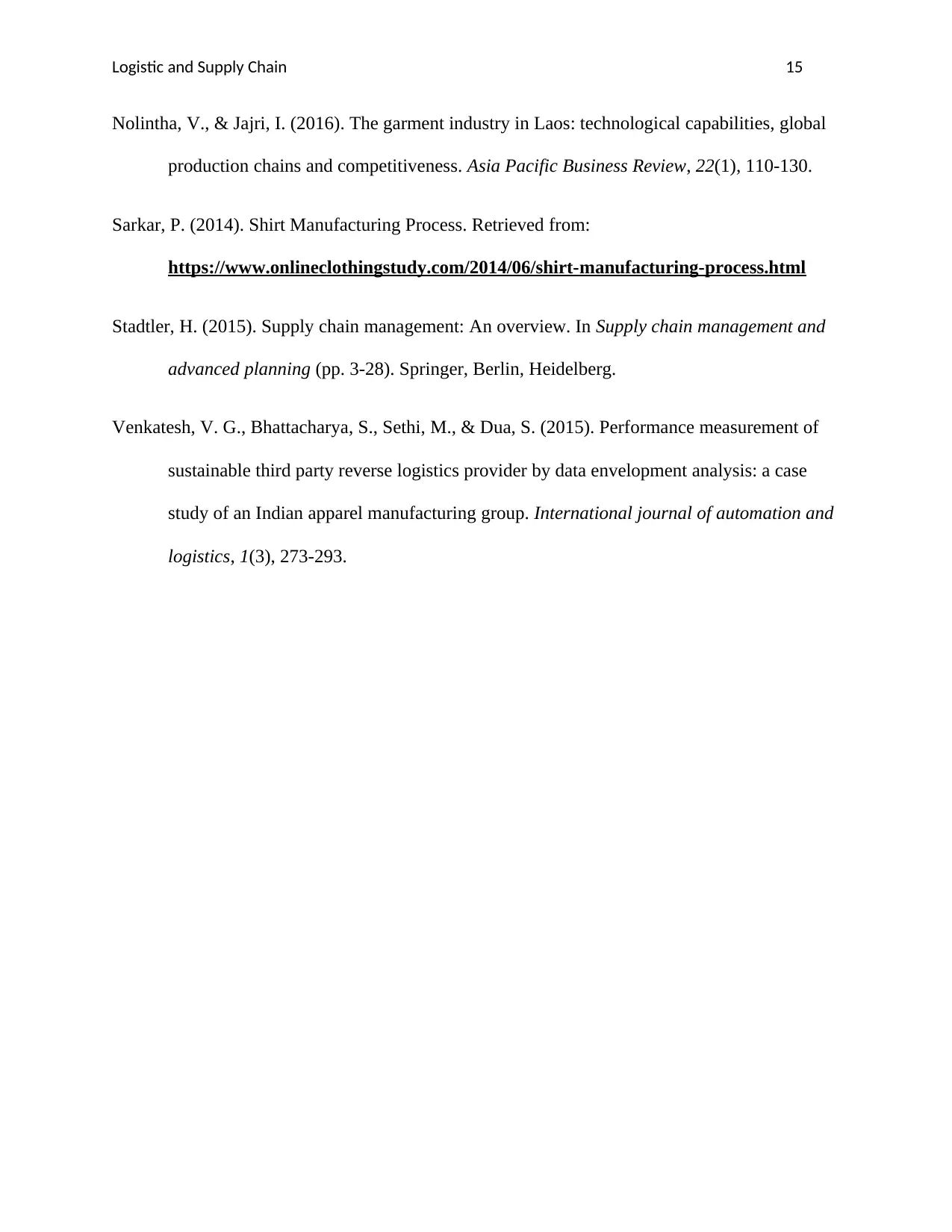
Logistic and Supply Chain 15
Nolintha, V., & Jajri, I. (2016). The garment industry in Laos: technological capabilities, global
production chains and competitiveness. Asia Pacific Business Review, 22(1), 110-130.
Sarkar, P. (2014). Shirt Manufacturing Process. Retrieved from:
https://www.onlineclothingstudy.com/2014/06/shirt-manufacturing-process.html
Stadtler, H. (2015). Supply chain management: An overview. In Supply chain management and
advanced planning (pp. 3-28). Springer, Berlin, Heidelberg.
Venkatesh, V. G., Bhattacharya, S., Sethi, M., & Dua, S. (2015). Performance measurement of
sustainable third party reverse logistics provider by data envelopment analysis: a case
study of an Indian apparel manufacturing group. International journal of automation and
logistics, 1(3), 273-293.
Nolintha, V., & Jajri, I. (2016). The garment industry in Laos: technological capabilities, global
production chains and competitiveness. Asia Pacific Business Review, 22(1), 110-130.
Sarkar, P. (2014). Shirt Manufacturing Process. Retrieved from:
https://www.onlineclothingstudy.com/2014/06/shirt-manufacturing-process.html
Stadtler, H. (2015). Supply chain management: An overview. In Supply chain management and
advanced planning (pp. 3-28). Springer, Berlin, Heidelberg.
Venkatesh, V. G., Bhattacharya, S., Sethi, M., & Dua, S. (2015). Performance measurement of
sustainable third party reverse logistics provider by data envelopment analysis: a case
study of an Indian apparel manufacturing group. International journal of automation and
logistics, 1(3), 273-293.
1 out of 15
Your All-in-One AI-Powered Toolkit for Academic Success.
+13062052269
info@desklib.com
Available 24*7 on WhatsApp / Email
![[object Object]](/_next/static/media/star-bottom.7253800d.svg)
Unlock your academic potential
© 2024 | Zucol Services PVT LTD | All rights reserved.